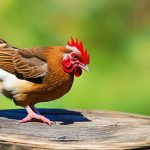Ocelots are wild felines native to the Americas, characterized by their distinctive spotted coats and agile nature. These solitary and territorial animals can occupy ranges up to 18 square miles. Primarily nocturnal, ocelots hunt small mammals, birds, and reptiles.
Their climbing and swimming abilities make them effective predators in their natural habitats. Protecting chicken coops from ocelots requires an understanding of their behavior. These cats are stealthy and opportunistic hunters, often difficult to detect until they’ve already struck.
Their elusive nature necessitates proactive measures to safeguard poultry. Ocelots’ territorial behavior is another crucial factor in coop protection. They mark their territory with urine and scratch marks.
Effective chicken coop security should include barriers that discourage ocelots from entering the area. By comprehending ocelot behavior, poultry owners can implement strategies to protect their chickens and minimize potential conflicts with these wild cats.
Table of Contents
Key Takeaways
- Ocelots are nocturnal and solitary animals, known for their agility and hunting skills.
- Securing the chicken coop with sturdy fencing and locks can help prevent ocelots from accessing the area.
- Installing motion-activated lights and alarms can startle ocelots and deter them from approaching the chicken coop.
- Using natural deterrents such as citrus peels, cayenne pepper, or predator urine can help keep ocelots away from the coop.
- Creating a barrier around the chicken coop with a combination of fencing, mesh, and electric wire can provide added protection against ocelot intrusion.
- Removing attractants such as food scraps, garbage, and overgrown vegetation from the area can help reduce ocelot activity near the coop.
- Seeking professional help from wildlife experts or animal control if ocelot activity poses a persistent threat to the chicken coop.
Securing the Chicken Coop
Building a Secure Fence
This can be achieved by installing a sturdy fence that is at least 6 feet high and extends underground to prevent digging.
Reinforcing the Coop
In addition to a secure fence, it’s important to reinforce the coop itself with strong materials that cannot be easily broken into. This includes using heavy-duty wire mesh on windows and vents, as well as sturdy locks on doors.
Regular Inspections and Maintenance
It’s also important to regularly inspect the coop for any weak spots or vulnerabilities that could be exploited by ocelots. Another important aspect of securing the chicken coop is to ensure that there are no gaps or openings that ocelots can squeeze through. This includes sealing any cracks or holes in the walls or roof of the coop, as well as securing any loose or flimsy materials that could be easily manipulated by a determined ocelot.
By taking these measures, you can significantly reduce the risk of ocelot attacks on your chickens.
Installing Motion-Activated Lights and Alarms
Installing motion-activated lights and alarms around the chicken coop can be an effective deterrent against ocelots. Ocelots are primarily nocturnal hunters, so bright lights can startle them and discourage them from approaching the coop. Motion-activated lights are a great way to conserve energy while still providing a strong deterrent against potential threats.
In addition to lights, installing alarms that are triggered by motion can also help scare off ocelots. Loud noises can startle and disorient ocelots, making them less likely to approach the coop. This can be especially effective when used in combination with bright lights, creating a strong deterrent against potential attacks.
It’s important to strategically place these lights and alarms around the perimeter of the chicken coop to ensure maximum coverage. This will help create a barrier of protection that will make it difficult for ocelots to approach undetected. By utilizing motion-activated lights and alarms, you can significantly reduce the risk of ocelot attacks on your chickens while also minimizing the impact on your energy consumption.
Using Natural Deterrents
In addition to lights and alarms, using natural deterrents can also help keep ocelots away from your chicken coop. Ocelots have a strong sense of smell, so using natural scents that they find unpleasant can discourage them from approaching the area. This can include using citrus peels, vinegar, or strong-smelling herbs around the perimeter of the coop.
Another natural deterrent is the use of predator urine, such as that of a coyote or wolf. Ocelots are territorial animals and will avoid areas that are marked by potential predators. By strategically placing predator urine around the coop, you can create a barrier that will discourage ocelots from approaching.
It’s important to regularly refresh these natural deterrents to ensure their effectiveness, as their potency can diminish over time. By using natural deterrents in combination with other strategies, you can create a multi-layered defense system that will make it difficult for ocelots to approach your chickens.
Creating a Barrier around the Chicken Coop
Creating a physical barrier around the chicken coop is another effective way to protect your flock from ocelot attacks. This can include using hardware cloth or welded wire fencing to create a secure enclosure that is difficult for ocelots to breach. It’s important to bury the fencing at least 12 inches underground to prevent digging, as well as extending it at least 6 feet high to deter climbing.
In addition to fencing, creating a barrier can also involve using natural obstacles such as thorny bushes or dense vegetation around the perimeter of the coop. Ocelots are agile hunters, but they may be deterred by obstacles that make it difficult for them to approach undetected. By creating a natural barrier, you can add an extra layer of protection for your chickens.
It’s important to regularly inspect and maintain the barrier around the chicken coop to ensure its effectiveness. This includes trimming back any overgrown vegetation or repairing any damage to the fencing. By creating a strong physical barrier, you can significantly reduce the risk of ocelot attacks on your chickens.
Removing Attractants from the Area

Removing Attractants
Secure garbage cans and compost bins to prevent scavenging animals that may attract ocelots. Keep the area around the coop free of fallen fruit or bird feeders that may draw in small mammals or birds, which could attract ocelots.
Minimizing Hiding Spots
In addition to removing attractants, keep the area around the coop well-lit and free of hiding spots for potential prey. Trim back overgrown vegetation and remove any debris or clutter that could provide cover for small animals. By removing attractants and minimizing hiding spots, you can make the area less appealing to ocelots.
Regular Monitoring
Regularly monitor the area around the chicken coop for any potential attractants and take steps to remove them promptly. By minimizing potential prey sources, you can reduce the likelihood of ocelots being drawn to the area and posing a threat to your chickens.
Seeking Professional Help if Necessary
If despite your best efforts, you continue to experience issues with ocelot attacks on your chicken coop, it may be necessary to seek professional help. This can include contacting local wildlife authorities or conservation organizations for assistance in dealing with ocelot conflicts. These professionals can provide valuable guidance and resources for implementing effective strategies to protect your chickens from ocelot attacks.
In some cases, it may be necessary to consider more advanced measures such as trapping and relocating problem ocelots. However, this should only be done under the guidance of professionals who have experience in dealing with wildlife management. It’s important to approach these situations with caution and respect for the natural habitat of ocelots.
By seeking professional help if necessary, you can ensure that you are taking appropriate measures to protect your chickens while also respecting the natural behavior and habitat of ocelots. Professional assistance can provide valuable support in addressing ocelot conflicts and finding sustainable solutions for coexisting with these beautiful wild cats. In conclusion, protecting your chicken coop from ocelot attacks requires a multi-faceted approach that takes into account the behavior and habits of these elusive predators.
By understanding their behavior, securing the coop, installing deterrents, creating barriers, removing attractants, and seeking professional help if necessary, you can effectively safeguard your flock from potential threats posed by ocelots. With careful planning and implementation of these strategies, you can create a safe and secure environment for your chickens while also respecting the natural habitat of ocelots in their native range.
If you’re looking for more tips on keeping your chickens safe, check out this article on how to build a secure chicken coop in Chester, SC. It offers valuable advice on creating a safe and predator-proof environment for your chickens.
FAQs
What are ocelots?
Ocelots are wild cats native to the Americas, known for their beautiful spotted fur and nocturnal hunting habits. They are skilled predators and can pose a threat to small animals, including chickens.
Why do ocelots pose a threat to chickens?
Ocelots are carnivorous predators and may see chickens as potential prey. They are known to hunt small animals, and chickens can be vulnerable to ocelot attacks, especially at night.
How can I keep ocelots away from my chickens?
There are several methods to deter ocelots from preying on chickens. These include securing the chicken coop with sturdy fencing, using motion-activated lights or sound devices to scare off ocelots, and keeping the area around the coop free of dense vegetation where ocelots can hide.
Are there any natural deterrents for ocelots?
Some natural deterrents for ocelots include using strong-smelling plants like lavender or citrus around the chicken coop, as ocelots are known to dislike strong scents. Additionally, some people have had success with using predator urine or hair from larger animals to deter ocelots.
What should I do if I spot an ocelot near my property?
If you spot an ocelot near your property, it’s important to keep a safe distance and avoid approaching the animal. Contact local wildlife authorities or animal control for guidance on how to safely handle the situation. It’s important to remember that ocelots are wild animals and should be treated with caution.
Meet Walter, the feathered-friend fanatic of Florida! Nestled in the sunshine state, Walter struts through life with his feathered companions, clucking his way to happiness. With a coop that’s fancier than a five-star hotel, he’s the Don Juan of the chicken world. When he’s not teaching his hens to do the cha-cha, you’ll find him in a heated debate with his prized rooster, Sir Clucks-a-Lot. Walter’s poultry passion is no yolk; he’s the sunny-side-up guy you never knew you needed in your flock of friends!







